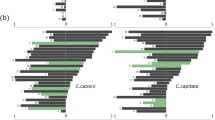Abstract
Saprophytic fungi have degradative abilities and interspecific interactions which suggest that resource use and yield should increase as species number increases, but previous studies show the opposite. As a test of the possibility that invertebrate activity changes fungal resource use patterns, we grew coprophilous fungi on rabbit feces at the same initial density singly or in mixtures of 2, 4, or 6 species, with or without activity of larvalLycoriella mali (Diptera: Sciaridae). Fungi in mixtures without larvae caused less weight loss in one mixture, and greater weight loss in 2 mixtures than when growing alone; fungi in 4 of 6 mixtures produced fewer spores than when growing alone. Overall, without larvae, weight loss did not increase as number of fungal species increased. Larvae did not change the pattern of weight loss or proportions of spores caused by mixing fungal species. Numbers of larvae surviving to pupate rose as fungal species numbers increased; as a result, weight loss increased with fungal species number in cultures with larvae.
Similar content being viewed by others
References
Angel K, Wicklow DT (1974) Decomposition of rabbit faeces: an indication of the significance of the coprophilous microflora in energy flow schemes. J Ecology 62:429–437
Asthana RP, Hawker LE (1936) The influence of certain fungi on the sporulation ofMelanospora destruens Shear, and some other ascomycetes. Ann Botany (London) 50:325–344
Bahn M, Hock B (1973) Morphogenese vonSordaria macrospara: die indukation der perithezienbildung. Ber Deut Bot Gesell 86:309–311
Binns ES (1981) Fungus gnats (Diptera:Mycetophilidae/Sciaridae) and the role of mycophagy in soil: a review. Rev Ecol Biol Sol 18:77–90
Blanchette RA, Shaw CG (1978) Associations among bacteria, yeasts, and basidiomycetes during wood decay. Phytopathology 68:631–637
Buston HW, Rickard B (1956) The effect of a physical barrier on sporulation ofChaetomium globosum. J Gen Microbiol 15:194–197
Frankland JC (1969) Fungal decomposition of bracken petioles. J Ecol 57:25–36
Garret SD (1970) Pathogenic root-infecting fungi. Cambridge University Press, New York
Hanlon RDG, Anderson JM (1979) The effects of Collembola grazing on microbial activity in decomposing leaf litter. Oecologia 38:93–99
Harper JE, Webster J (1964) An experimental analysis of the coprophilous fungus succession. Trans Br Mycol Soc 47:511–530
Harper JL (1977) Population biology of plants. Academic Press, New York
Hawker LE (1966) Environmetal influences on reproduction. In: Ainsworth GC, Sussman AS (eds) The fungi. Vol. 2. Academic Press, New York, pp 435–469
Helsel ED, Wicklow DT (1978) Arthropod colonization of pre-aged as compared with fresh feces. Can Entomol 110:217–222
Ikediugwu FEO, Webster J (1970) Antagonism betweenCoprinus heptemerus and other coprophilous fungi. Trans Br Mycol Soc 54:181–204
Ingold C (1965) Spore liberation. Oxford University Press, New York
Lussenhop J, Kumar R, Wicklow DT, Lloyd JL (1980) Insect effects on bacteria and fungi in cattle dung. Oikos 34:54–58
Lysek G (1976) Formation of perithecia in colonies ofPodospora anserina. Planta 133:81–83
Martin MM (1979) Biochemical implications of insect mycophagy. Biological Reviews 54:1–21
Norman AG (1930) The biological decomposition of plant materials. III. Physiological studies on some cellulose decomposing fungi. Ann Appl Biol 17:575–613
Papendick RI, Sanchez PA, Triplett GB (eds) (1976) Multiple cropping. Am Soc Agronomy Special Publication 27
Pollock RT (1973) Environmental factors affecting the pattern of perithecium development inSordaria fimicola on agar medium. Bull Torrey Bot Club 100:78–83
Rayner ADM (1976) Dematiaceous hyphomycetes and the narrow dark zones in decaying wood. Trans Br Mycol Soc 67:546–549
Risch SJ (1981) Insect herbivore abundance in tropical monocultures and polycultures: an experimental test of two hypotheses. Ecology 62:1325–1340
Risch SJ, Hansen MK (1982) Plant growth, flowering phenologies, and yields of corn, beans, and squash grown in pure stands and mixtures in Costa Rica. J Appl Ecol 19:901–916
Robinson W (1926) The conditions of growth and development ofPyronema confluens Tul (P omphalodes (Bull) Fuckel) Ann Bot (London): 40:245–272
Saito T (1965) Coactions between litter-decomposing Hymenomycetes and their associated microorganisms during decomposition of beech litter. Sci Rep Tohoku Univ 31:255–273
Salonius PO (1981) Metabolic capabilities of forest soil microbial populations with reduced species diversity. Soil Biol Biochem 13:1–10
Shapiro SS, Wilk MB (1965) An analysis of variance test for normality (complete samples). Biometrika 52:591–611
Webster J (1970) Coprophilous fungi. Trans Br Mycol Soc 54:161–180
Wicklow DT, Detroy RW, Adams S (1980) Differential modification of the lignin and cellulose components in wheat straw by fungal colonists of ruminant dung: ecological implications. Mycologia 72:1065–1076
Wicklow DT (1981) The coprophilous fungal community: a mycological system for examining ecological ideas. In: Wicklow DT, Carroll GC (eds) The fungal community, its organization and role in the ecosystem. Dekker, New York, pp 47–76
Wicklow DT, Yocom DH (1981) Fungal species numbers and decomposition of rabbit feces. Trans Br Mycol Soc 76:29–32
Wicklow DT, Yocom DH (1981) Effect of larval grazing byLycoriella mali (Diptera:Sciaridae) on species abundance of coprophilous fungi. Trans Br Mycol Soc 78:29–32
Yocom DH, Wicklow DT (1980) Community differentiation along a dune succession: an experimental approach with coprophilous fungi. Ecology 61:868–880
Author information
Authors and Affiliations
Rights and permissions
About this article
Cite this article
Lussenhop, J., Wicklow, D.T. Interaction of competing fungi with fly larvae. Microb Ecol 11, 175–182 (1985). https://doi.org/10.1007/BF02010489
Issue Date:
DOI: https://doi.org/10.1007/BF02010489




